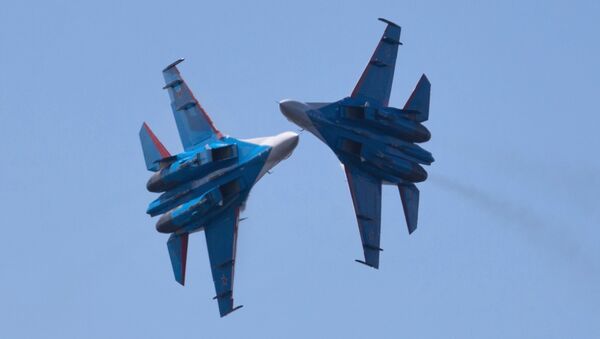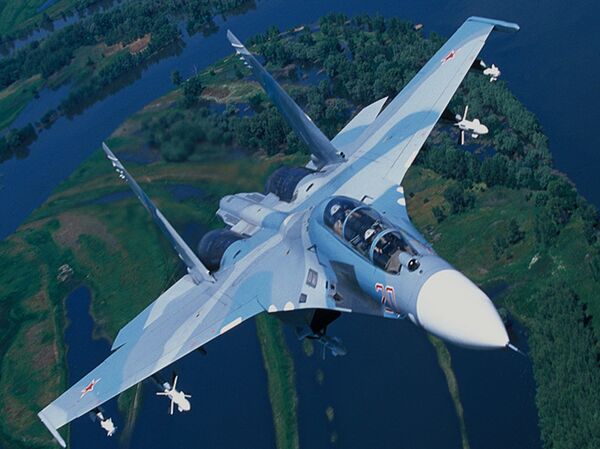Russia's Su-27 rightly serves as a symbol of Russia's defense industry of the second part of the 20th century, on a par with the T-72 tank and Kalashnikov assault rifle. In this particular aircraft, the USSR implemented all of the most advanced technologies of the Soviet school of aircraft engineering, thanks to which the aircraft is ready for almost limitless modifications.
Dozens of modified Su-27 jets nowadays patrol the skies of more than 20 countries, and constant design and engineering support means that the service life of this graceful bird is far from over.
Sputnik reviews the history of development and modification of the aircraft.
Everything began at Sukhoi Design Bureau at the end of 1969. The USSR needed an air superiority fighter to catch up with the US' F-15 fighter being developed in the US under the FX program from 1966.

The prototype of the Su-27, factory code T-10, was finished by September 1971. After the concept was presented, Soviet Air Force heads decided to move ahead with two designs in parallel. A lighter version by Mikoyan (now known as the MiG-29, NATO reporting name Fulcrum), and a heavier version by Sukhoi.
In 1976, Sukhoi started to build its first three T-10 prototypes (two for flight testing and one for structural testing). The first two flying prototypes of the Su-27 were fitted with AL-21FZAI engines.
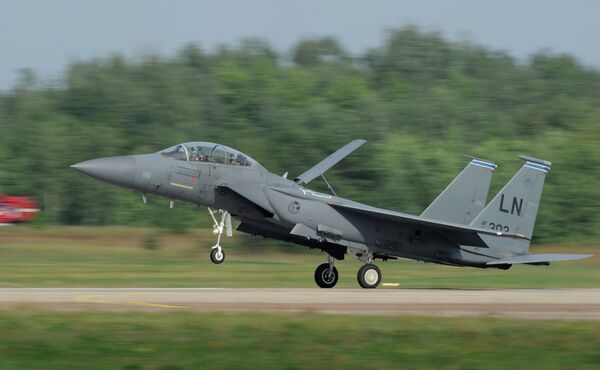
Construction of the first prototype T10-1 was completed in April 1977 and on May 20, 1977 it made its first test flight.
In May 1978, the testing program was expanded to cover a second prototype, the T-10-2, and the year after that, in 1979, it received the prototypes T-10-3 and T-10-4, fitted with AL-31F engines.
The aircraft however had shortcomings in the fly-by-wire (FBW) system that replaced the conventional manual flight controls of the aircraft with an electronic interface.
Extensive redesigns followed (T-10-3 through to T-10-15) and a revised version of the T-10-7, designated the T-10S, made its first flight on April 20,1981.
The T-10S was lost in an accident on September 3, 1981. The second T-10S came from the production line with the designation T-10-12 and a new airframe. That prototype was lost too, on December 23, 1981.
Eventually the T-10-15 demonstrator, T-10S-3, evolved into the definitive Su-27 configuration.
The T-10S-3 was modified and officially designated the P-42, setting a number of world records for time-to-height, beating those set in 1975 by a similarly modified F-15 called "The Streak Eagle."
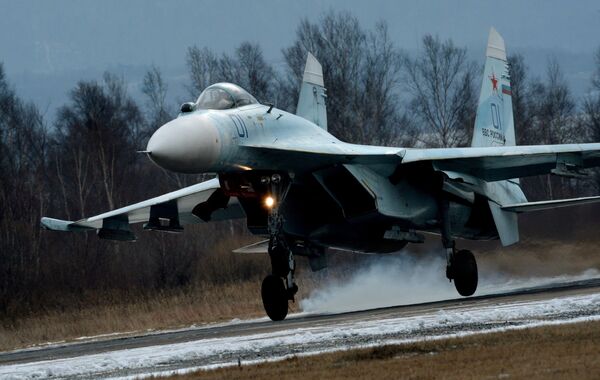
For its record attempt, the P-42 was stripped of all armaments, radar and operational equipment. The fin tips, tail-boom and the wingtip launch rails were also removed. The composite radome was replaced by a lighter metal version. The aircraft was stripped of paint, polished and all drag-producing gaps and joints were sealed. The engines were modified to deliver an increase in thrust of 1,000 kg (2,200 lb), resulting in a thrust-to-weight ratio of almost 2:1.
The production Su-27 (NATO designation Flanker) began to enter operational service in 1985, although manufacturing difficulties kept it from appearing in strength until 1990.

The Su-27 is a highly integrated twin-finned aircraft. The airframe is constructed of titanium and high-strength aluminum alloys. The engine nacelles are fitted with trouser fairings to provide a continuous streamlined profile between the nacelles and the tail beams. The fins and horizontal tail consoles are attached to tail beams.
The central beam section between the engine nacelles consists of the equipment compartment, fuel tank and the brake parachute container. The fuselage head is of semi-monocoque construction and includes the cockpit, radar compartments and the avionics bay.
The aircraft is equipped with a 30mm GSh-301 gun with 150 rounds of ammunition and a range of missiles, rockets and bombs mounted externally on ten hardpoints.
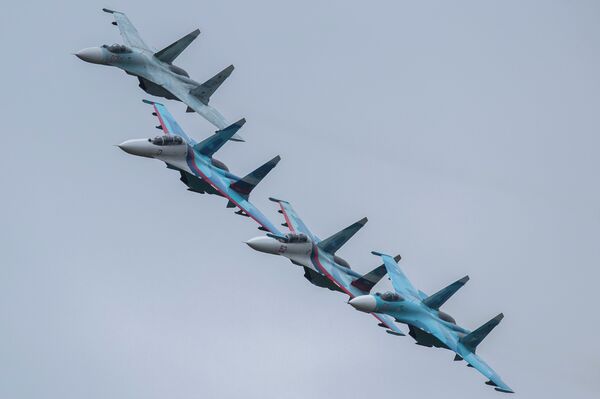
Its infrared search and track system, laser rangefinder, radar and helmet-mounted target designator provide detection, tracking and attack capability.
The range of air-to-air missiles carried by the Su-27 aircraft includes: R-27R1 (NATO designation AA-10A Alamo-A), all-aspect medium-range missile with semi-active radar homing and R-27T1 (AA-10B Alamo-B) with infrared homing and a range from 500m to 60km; and R-73E (AA-11 Archer) all-aspect, close-combat air-to-air missile with infrared homing and a range from 300m to 20km.
Ordnance for air-to-ground missions include: 100kg, 250kg and 500kg freefall and retarded aerial bombs; 500kg incendiary devices; 25kg and 500kg RBK cluster bombs; and C-8, C-13 and C-25 unguided aerial missiles.

The Su-27 is equipped with a new electronic countermeasures suite for individual aircraft, and for mutual and group protection in the forward and rear hemispheres.
The countermeasures system includes a pilot illumination radar warning receiver, chaff and infrared decoy dispensers, and an active multi-mode jammer located in the wingtip pods.
The Su-27 is equipped with a Phazotron N001 Zhuk coherent pulse Doppler radar with track-while-scan and look-down / shoot-down capability.
The range of the radar against 3m² targets is over 100km in the forward hemisphere and 40km in the rear hemisphere. The radar has the capacity to search, detect and track up to ten targets with automatic threat assessment and prioritization.

The aircraft has an OEPS-27 electro-optic system, which includes an infrared search-and-track (IRST) sensor collimated with a laser rangefinder. The range of the electro-optical system is 40-100km, depending on the aspect angle presented by the target.
The Su-27 is in service with Russia, Ukraine, Belarus, Kazakhstan, Indonesia, Uzbekistan and Vietnam, and is built under license in China as the F-11. A variant, the Su-30MK, has been sold to India with licensed local production.
In May 2006, the Su-27 was selected by the Mexican Navy. It required ten aircraft, eight single-seat and two Su-27UB two-seat trainers.
In August 2007, Indonesia ordered a further three Su-27SKM and three Su-30MK2 aircraft.
The latest version is the Su-27SM, an upgrade for the Russian Air Force which has strengthened fuselage for extra weapons payload, improved N001 radar, glass cockpit with three-color multi-function displays and improved avionics. The first was delivered in December 2003.
Back in August 1992, a group of Russian Air Force Su-27s made a friendly visit to the USAF air base Langley. During that visit a proposition was made to the American side to have a demonstration dogfight between Su-27 and F-15.The flight involved one Su-27UB, one F-15D and one F-15C.
The Su-27 rose to the challenge and triumphed.
The F-15D was not able to shake the Su-27 from its tail: using only minimum afterburners and maximum non-afterburning thrust the Russian fighter without much effort managed to stay behind the F-15D, whose engines were set to full afterburning thrust.
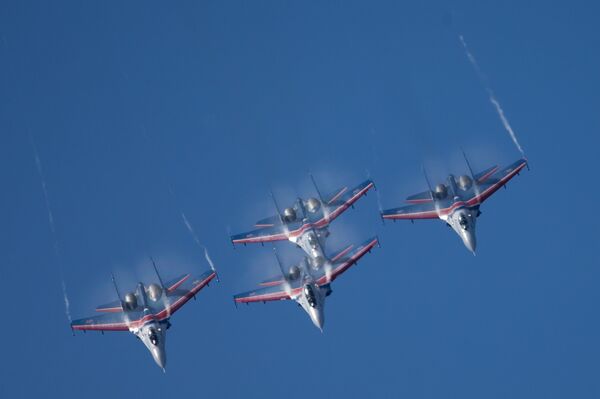
During this chase, the Su-27's AOA never exceed 18 degrees. At the same time Su-27 faced with the same task easily lost the F-15C and was soon on its tail and not long after that the F-15D became another target.
Back in 2015, the Indian Air Force pilots flying Sukhoi Su-30 MKI had a resounding 12-0 scoreline in their favor against Royal Air Force Typhoon jets in Within Visual Range (WVR) dogfighting operations, part of joint air combat exercise.
It is expected that the Su-27 family will maintain its presence over the modern battlefield for some decades to come, more so as the Sukhoi T-50 PAK-FA makes it appearance in suitable numbers for the Russian Air Force.


